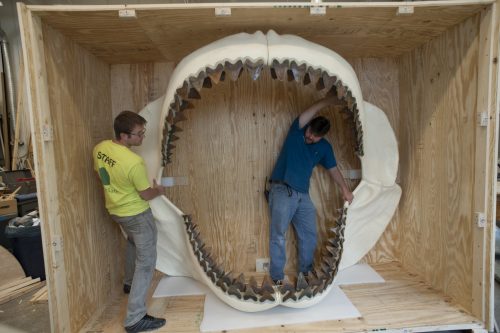The Florida Museum of Natural History recently shipped the jaws of a Megalodon shark to Panama for display in the Biomuseo, a new science museum scheduled to open next year.

The specimen arrived in Panama in October as part of a long-term loan to the new natural history museum, expected to open during the first quarter of 2014. Florida Museum vertebrate paleontology curator Bruce MacFadden said the facility, located along the Panama Canal and designed by architect Frank Gehry, will be a world-class public exhibit space showcasing the country’s biodiversity and natural history.
“The Biomuseo is beautifully placed on the entryway to Panama, and it’s going to be a signature architectural iconic image for the entire city,” MacFadden said. “Our participation in helping museum initiatives like the Biomuseo extends the reach of the science and diffuses the science into the public sphere.”
The sharks’ teeth were collected in the U.S. and the reconstructed fiberglass jaw represents a fossil species commonly found in Panama. Megalodon was an apex predator that became extinct about 2 million years ago. The jaw measures about 7 feet by 7 feet, and the entire shark likely reached 60 feet in length, MacFadden said.
“Every fossil collector knows about Megalodon,” said MacFadden, a principal investigator of the Panama Canal Project, funded by the National Science Foundation’s Partnerships in International Research and Education initiative. “It’s probably, along with dinosaurs, one of the most charismatic extinct species that we know of.” “We want to give specimens like this to Panama that will help visitors and residents better understand the ancient biodiversity of the country.”
Cliff Jeremiah, a retired physician living in Jacksonville, originally donated the jaw to the Florida Museum about a decade ago. He collected the teeth from the Cooper River in South Carolina and built the jaw by hand using fiberglass and glue. Because sharks are cartilaginous, their jaws are rarely preserved as fossils, MacFadden said.
“When the animals die, the cartilage is organic and just disintegrates, and that’s why you get all these sharks teeth that are all isolated,” MacFadden said.
The Florida Museum’s partnership with the Biomuseo is part of the Panama Canal Project’s outreach and education objective. The jaw was previously housed in Dickinson Hall on the University of Florida campus, the Florida Museum’s primary research and collections facility that is not open to the public. Jeremiah said he was pleased the jaw would be showcased in another museum.
“It’s a good idea to reach out,” Jeremiah said. “I put a lot of these jaws together for people because I know it keeps the collection of teeth together, and it increases the enjoyment for people to see a jaw built somewhere, rather than just see an isolated tooth.”
Because the teeth came from different individual sharks, it is impossible to date the specimen. Scientists believe Megalodon existed from 18 million years ago to 2 million years ago, and Florida Museum researchers are currently investigating the possibility that Panama was an ancient nursery for the giant sharks.
The Panama Canal Project supports paleontological excavation of the Panama Canal during construction expected to continue through 2014. Fieldwork conducted by Florida Museum participants has given scientists a better understanding of the animals that existed in tropical waters before the formation of the Isthmus of Panama when the Atlantic and Pacific oceans were still connected. Megalodon fossils discovered in Panama are typically about 10 million years old, MacFadden said.
Learn more about Vertebrate Paleontology at the Florida Museum.